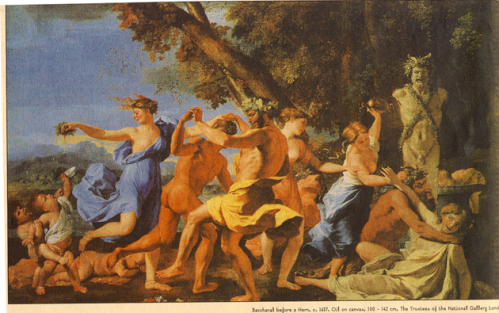Poussin in the Age of Pop Video
I went to the Poussin show at the Royal Academy. He is our first interactive artist. Totally contemporary, as if he is about to burst onto the New York art scene tomorrow. Our present art and design understanding owes a lot to him. Poussin painted fairly small paintings. If you think of videos, films and commercials on t.v. and then think of the epics that such a small size screen can show then Poussin starts to make sense. In viewing each painting I was reminded of my wanderings through an arcade flashing with computer graphics on monitors. Assembled are a cast of costumed characters, theatrically lit against a fake backdrop, acting and gesturing to each other in little groups. This is the play world of models and games transformed using paint. The stories all seem complicated, some biblical and some mythological, but they are explained at the side like t.v. reviews. The paintings are modern in that they seem very formulaic. They show weddings, dancing at parties, courtships and tragic deaths. I could have been watching Eastenders or an Australian soap.
The world is painted without much fuss. It is cool but it is intimate; I felt I was being asked to believe I was looking at something that had been created especially for me. Poussin has given us a world of action adventure. He does this, not by attempting to develop characters in his painting; instead he develops gestures, all fitting into his highly unusual but complete world. People are not painted to express any individuality. They are not real people but are used as props to display a range of gestures. They refer back to the cardboard cut out figures the artist used to help him create and arrange compositional poses.

Image: Eliezer and Rebecca, c. 1648. Oil on Canvas, Musee de Louvre, Departement des Peintures, Paris.
Poussin is economical as a painter. He doesn't paint textures very much. Everything looks like it is painted from the same material. As there is no fur or lace or velvet there is little to show off his skills as a master painter. Marble does not look like marble. There is no attempt to convince the viewer it is real; it is painted as a prop because it is to be seen as a prop. 1950's sci-fi films owes a lot to Poussin's understanding of making a fake world seem real. If you look at the sets from Hollywood musicals and look at Poussin you can see a similar way of picturing. Palm trees stand in for exotic locations but sometimes they are found next to oak trees.
A believable world is built up through incidental details. Poussin is a master at painting sandals and feet which are firmly rooted to the ground. The figures are balanced in odd and awkward ways. Poussin is always supremely inventive. Putti are placed at specific angles unlike the confetti putti of other painters; I observed his delight in seeing them improbably arranged to float, yet be so fat.
There are many conventional details which have been rethought by the artist to make them his own and fit into a complete world. The ascending virgin travels light. In the painting on show at the Royal Academy, she is without an entourage and paparazzi, like a Euro royal out for a quick shop with minimal fuss and minimal effort. Here the path to heaven is seen as very uncluttered.

Image: Bacchanal Before a Hern, c. 1637. Oil on Canvas, The Trustees of the National Gallery, London
Poussin has a particular way of painting horses and giving them individual expressions that are recognisable as human. The horses' hair is plaited in different ways in different paintings. I was reminded of childrens' toy horses. They sway over but do not fall down.
All of these controlled scenes are also scenes of chaos. A naked muscular man rides four horses. Poussin's battle scenes make Tom of Finland orgies look unchoreographed and spontaneous. He is at his best when crowding his canvas with people doing extraordinary things, as if they are normal. He works out the smallest details. He invents how putti throw flowers. He makes the gestures over emphatic - it is as funny and fascinating as the world of the heavy metal cartoonist.
It was strange looking at the whole of someone's life through their work. I could see what was a constant interest and what was a passing fad. Nothing in Poussin for me was boring. On show is the world of the fake. The empty is used to describe the highly emotional. Everything is worked out. It has made me rethink the modern world, and how Poussin's world is so connected in thought, feeling and intellectual concerns to our own visual world. The closer I get to his inauthentic world, the closer I come to understanding the concerns of my own age.
THE END
Mute Books Orders
For Mute Books distribution contact Anagram Books
contact@anagrambooks.com
For online purchases visit anagrambooks.com






